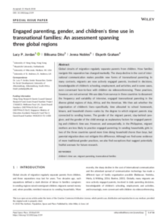Abstract
Global circuits of migration regularly separate parents from children. How families navigate this separation has changed markedly. The sharp decline in the cost of international communication makes possible new forms of transnational parenting. In many contexts, migrants are now actively engaged parents, involved in decisions, knowledgeable of children's schooling, employment, and activities, and in some cases, even conversant face‐to‐face with children via videoconferencing. These practices, however, are not universal. We use data from surveys in three countries to document the frequency and variability of intensive, engaged transnational parenting in the diverse global regions of Asia, Africa, and the Americas. We then ask whether the organisation of children's lives—specifically, time allocated to school homework, leisure, and household chores—varies by the degree to which migrant parents stay connected to sending homes. The gender of the migrant parent, stay‐behind caregiver, and the gender of the child emerge as explanatory factors for engaged parenting and children's time use. However, and unexpectedly, in the Philippines, migrant mothers are less likely to practice engaged parenting. In sending households, girls in two of the three countries spend more time doing household chores than boys, but parental migration does not mitigate this difference. Although we find some evidence of more traditional gender practices, we also find exceptions that suggest potentially fruitful avenues for future research.
This article is part of the Special Issue of Population, Space and Place on Transnational Families

